To expand coverage of Indigenous issues in the local and national communities, the Walter Cronkite School of Journalism and Mass Communication and Gaylord College of Journalism and Mass Communication at the University of Oklahoma have teamed up.
Journalism students at both universities will work with each other to publish stories about the pressing issues in Indigenous communities nationally. The partnership began this semester, and students from both of the journalism schools will be sharing a space in ASU’s Barrett and O’Connor Washington Center, located in Washington, D.C.
John Schmeltzer, community journalism professor and content director for Gaylord News at the University of Oklahoma, said this collaboration has been in the works since last summer.
“Cronkite was trying to expand and provide more coverage and we were in the process of putting together a Native American reporting center that would operate as a training ground within the college for Native American journalists," Schmeltzer said. "And it just kind of all blended together at that point."
Nancy Spears, junior studying journalism at the University of Oklahoma and a member of the Cherokee Nation, said the partnership between the two journalism schools is significant because of each state's history and the strong presence of Indigenous people within them.
“You've got Arizona, it has about 22 recognized tribes in the state, or in Oklahoma, where there's, you know, 39 recognized tribes, that were very deep in native history,” Spears said. “We have all that history that makes it a really unique partnership just because we have that personal historical investment in the coverage.”
Kristin Gilger, interim dean of the Cronkite School, said the collaboration will strengthen the coverage of Indigenous communities.
Gilger said it "amplifies each other's work" and students will have the chance to have their work published across the nation, in addition to both the websites for Gaylord News and Cronkite News.
Both universities will cover and report Indigenous stories in teams or on their own. With the new partnership, both journalism schools hope to expand coverage of Indigenous issues beyond state boundaries.
“I think we're both committed to telling the stories, better and completely about the Native American communities in our United States,” Schmeltzer said.
In addition to covering local Indigenous news, the partnership will also focus on covering national stories, he said.
The University of Oklahoma and ASU have partnered together in the past for other journalism initiatives, such as the national Carnegie-Knight News21 program.
Both schools have already covered local Indigenous news stories, such as Oklahoma tribe volunteers working to support people during the snowstorm and a prom dress calling attention to missing and murdered Indigenous women located in the Smithsonian National Museum of American History "Girlhood" exhibit.
Spears said this partnership gives her a platform to highlight the work of the Indigenous community and how global issues, such as the COVID-19 pandemic, impact them.
“The simple answer is more and better coverage. You know, this is a portion of our people, our population, that still does not get (enough coverage),” Gilger said. “I think the coverage is warranted.”
In addition to reporting, both schools' students are currently taking a course that specializes in educating students on how to report and cover Indigenous communities, Gilger said.
“This partnership is really on a huge trend of trying to really increase and improve and prioritize Indigenous coverage more,” Spears said.
Vanessa Ruiz, director for diversity initiatives and community engagement and professor of practice at the Cronkite School, wrote in an email the new partnership is another way in which Cronkite continues its mission of making its education accessible and illustrate the contributions of different communities through reporting.
“We want to lead the charge in making that happen," Ruiz wrote. "Adding Native voices to cover and report on all kinds of issues is critical in order to do so in a way that is accurate and fair."
Reach the reporter at anatar12@asu.edu or follow @AnushaNat1 on Twitter.
Like The State Press on Facebook and follow @statepress on Twitter.
Continue supporting student journalism and donate to The State Press today.





